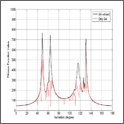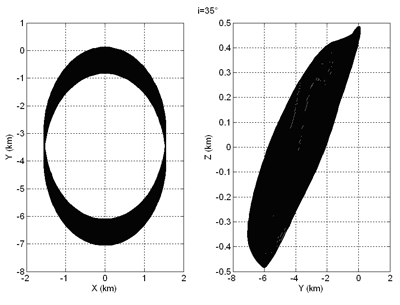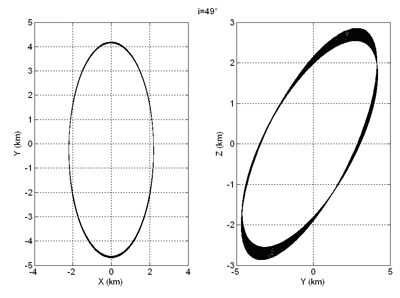Magic Inclinations

A search for bounded relative satellite motion has been carried out approaching the problem numerically as an optimisation problem. Two previously unknown inclination values, here referred to as "magic", were found.
Research Milestones
Two new inclination values, previously unknown, have been found to allow a periodical relative motion, namely 49 and 131 degrees.
Intrigued by this numerical result we tried to find an analytical explanation to the resonance phenomenon. Only to be "beaten" by S.R. Vadali, P. Sengupta, H. Yan and K.T. Alfriend of Texas A&M, who in their paper "On the fundamental frequencies of relative motion and the control of satellite formations", paper AAS 07-427, correctly relate the phenomenon to the matching of the in-plane and out of plane frequencies and find the exact values of 49.11 and 130.89 degrees.
Project overview
The possibility to obtain natural periodic relative motion of formation flying Earth satellites has been investigated both numerically and analytically. The numerical algorithm is based on a genetic strategy, refined by means of nonlinear programming, that rewards periodic relative trajectories. First, we tested our algorithm using a point mass gravitational model. In this case the period matching between the considered orbits is a necessary and sufficient condition to obtain invariant relative trajectories. Then, the J2 perturbed case was considered. For this case, the conditions to obtain an invariant relative motion are known only in approximated closed forms which guarantee a minimal orbit drift, not a motion periodicity. Using the proposed numerical approach, we improved those results and found two couples of inclinations (63.4° and 116.6°, the critical inclinations, and 49° and 131°, two new "special" inclinations) that are to be favoured by the dynamical system for obtaining periodic relative motion at small eccentricities. Below we report minimal drift relative orbits as obtainable at 35 degrees and at the newly discovered "magic" 49 degrees inclination. Benefits in terms of the control of a relative formation have also been assessed and found promising.

